Tamper Proof Packaging Market Report Scope & Overview:
The Tamper-proof Packaging Market is experiencing substantial growth on a global scale, driven by heightened consumer awareness regarding product safety, stringent regulations mandating tamper-evident features, and its expanding use across diverse industries. This market includes various solutions like shrink films, tamper-evident labels, induction sealing, and blister packs, catering to sectors such as pharmaceuticals, food and beverages, personal care, and electronics. Each industry has specific packaging safety standards.
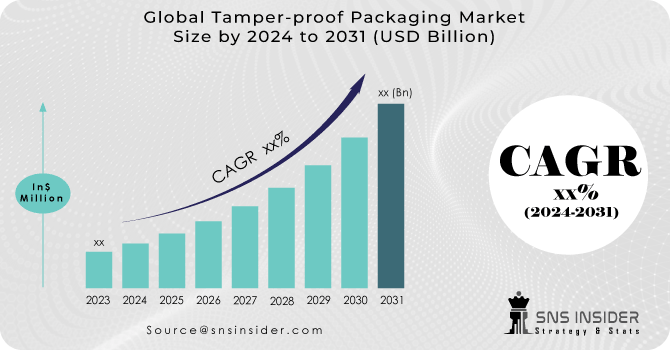
The surge in e-commerce has further boosted the adoption of tamper-proof packaging, as ensuring the security of products during transit has become a top priority. The market is propelled by continuous innovations in packaging technologies and materials, with a strong focus on sustainability and recyclability to meet the growing consumer demand for environmentally friendly packaging options. In the pharmaceutical sector, stringent regulations mandate the testing of tamper-evident packaging and strict adherence packaging guidelines. Increase in demand for ready-to-eat meals, frozen foods, and instant food products will boost the growth of tamper-proof packaging market.
MARKET DYNAMICS
KEY DRIVERS:
- Consumer Awareness and Product Safety Concerns
Increasing consumer awareness regarding the importance of product safety and the potential risks associated with tampering or contamination drives the demand for tamper-proof packaging.
- Ongoing innovations in packaging technologies and materials enhance the effectiveness of tamper-proof solutions
RESTRAIN:
- Implementing tamper-proof packaging solutions often involves additional costs, including the purchase of specialized materials and technologies.
OPPORTUNITY:
- Integration of Anti-Counterfeiting Technologies
Combining tamper-proof features with anti-counterfeiting technologies offers opportunities to enhance brand protection and consumer trust. Integration of technologies such as RFID and QR codes can provide additional layers of security.
- The Thriving E-commerce industry provides large opportunities for tamper-proof packaging manufacturers.
CHALLENGES:
- Compliance with diverse and evolving regulations across different regions and industries can be challenging.
- Tamper-proof packaging solutions finds difficult in adjusting with existing packaging systems can add compatibility challenges.
Impact of Russia Ukraine War
The Russia-Ukraine crisis has triggered widespread repercussions in global markets, affecting the tamper-proof packaging industry across various dimensions. Supply chains have been significantly disrupted, causing delays in the procurement of essential materials like plastics, adhesives, and metals crucial for tamper-proof packaging solutions. Raw material availability and costs are impacted due to the crisis-induced volatility in commodities supplied by Russia and Ukraine, leading to potential cost increases for manufacturers.
The market demand for tamper-proof packaging may experience shifts, with heightened concerns for product security during uncertain time’s potentially boosting demand, while economic downturn and reduced consumer spending could have the opposite effect. Geopolitical tensions may result in regulatory changes and increased trade barriers, necessitating adaptation by companies in the tamper-proof packaging sector. Strategic adjustments, such as diversifying supply chains and investing in alternative materials, become imperative for companies to navigate the uncertainties arising from such geopolitical conflicts.
Impact of Economic Slowdown
The provided graph depicts a scenario illustrating the impact of an economic slowdown on the annual growth rates of the Tamper-Proof Packaging Market. The graph initially shows a consistent growth trend, with annual rates ranging from 4.5% to 5% in the years leading up to 2020. The onset of the economic slowdown in 2020 is evident through a substantial downturn, resulting in a negative growth rate of 2%, indicating a contraction in the market.
Following the slowdown period, a gradual recovery is observed in the subsequent years. The growth rates slowly climb back into positive territory, albeit not immediately reaching the pre-slowdown levels. This nuanced trend underscores the lingering effects of an economic slowdown on the market's recovery, emphasizing the resilience and gradual rebound of the Tamper-Proof Packaging Market in the face of economic challenges.
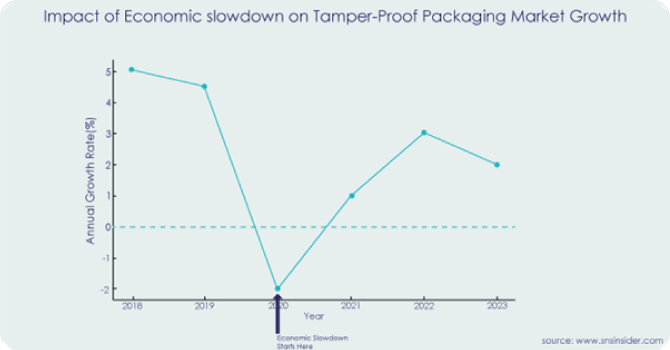
KEY MARKET SEGMENTS
By Material
- Plastics
- Metal
- Glass
- Paper Lids
- Others
By Product Type
- Induction seal
- Blister or strip packs
- Shrink sleeves
- Film wrappers
- Bubble packs
- Others
By End Use
- Food and beverages
- Pharmaceutical
- Cosmetics
- Others
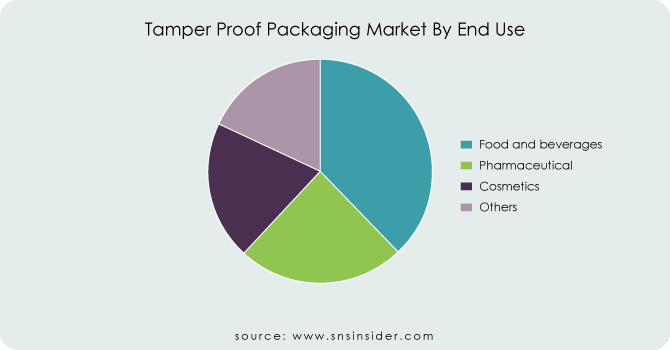
REGIONAL ANALYSIS
North America is anticipated to dominate the tamper-proof packaging market with share 40% during the forecast period, primarily due to stringent regulatory mandates and heightened consumer awareness regarding product safety. The market in this region is experiencing positive growth momentum, driven by factors such as the imposition of rigorous rules by the U.S. Food and Drug Administration (FDA) on pharmaceutical packaging and testing protocols, ensuring the integrity of medicines and drugs.
In contrast, the Asia Pacific region is expected to witness the highest Compound Annual Growth Rate (CAGR) in the tamper-evident packaging market. This growth is attributed to the robust expansion of the pharmaceutical, food and beverages, and cosmetics industries in the region. The increasing disposable income of consumers and the expanding urban population in countries like India and China are key contributors to the anticipated growth of tamper-evident packaging in the forecast period. Furthermore, the market is positively influenced by the growing awareness among consumers about food safety and the evolving lifestyles of individuals. These factors collectively contribute to the optimistic outlook for the tamper-evident packaging market in the coming years.
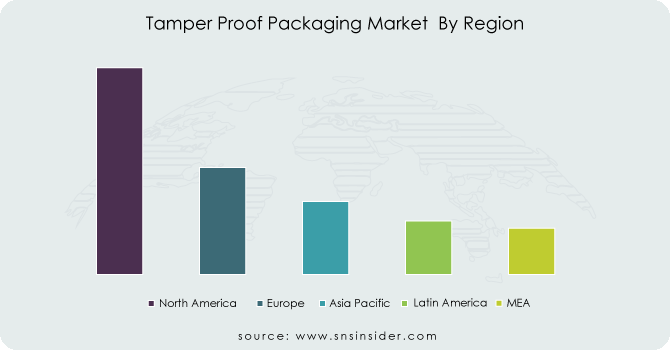
REGIONAL COVERAGE:
North America
- US
- Canada
- Mexico
Europe
- Eastern Europe
- Poland
- Romania
- Hungary
- Turkey
- Rest of Eastern Europe
- Western Europe
- Germany
- France
- UK
- Italy
- Spain
- Netherlands
- Switzerland
- Austria
- Rest of Western Europe
Asia Pacific
- China
- India
- Japan
- South Korea
- Vietnam
- Singapore
- Australia
- Rest of Asia Pacific
Middle East & Africa
- Middle East
- UAE
- Egypt
- Saudi Arabia
- Qatar
- Rest of Middle East
- Africa
- Nigeria
- South Africa
- Rest of Africa
Latin America
- Brazil
- Argentina
- Colombia
- Rest of Latin America
Key Players
Some of the major players in the Tamper Proof Packaging Market are Graham Packaging Company, Ball Corporation, ProAmpac, Sealed Air, Winpak Ltd, Amcor Limited, AEP Industries Inc, AEP Industries Inc, American Packaging Corporation, PRINTPACK, and other players.
Graham Packaging Company -Company Financial Analysis
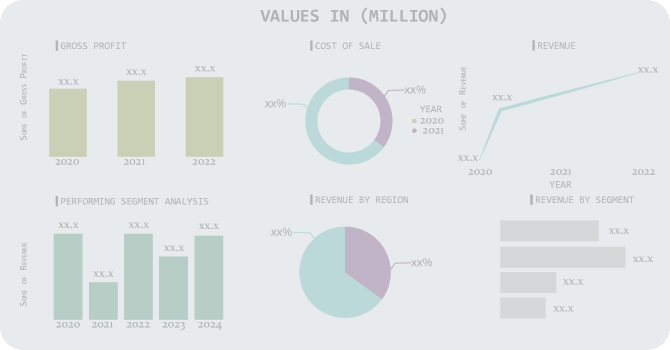
RECENT DEVELOPMENTS
- Securikett has introduced a new security seal made of paper, designed to protect cardboard packaging against a range of tampering methods and contribute to a circular economy.
- Schreiner MediPharm, a Germany based global provider of functional labelling solutions for the healthcare sector, has introduced a counterfeit and tampering protection solution that claims a void effect which makes it extremely difficult for counterfeiters to successfully reuse original packaging.
- Companies are looking forward in strategic partnerships and collaborations to enhance their market globe and increase their product offerings.
| Report Attributes | Details |
|---|---|
| Base Year | 2023 |
| Forecast Period | 2024-2031 |
| Historical Data | 2020-2022 |
| Report Scope & Coverage | Market Size, Segments Analysis, Competitive Landscape, Regional Analysis, DROC & SWOT Analysis, Forecast Outlook |
| Key Segments | • By Material (Plastics, Metal, Glass, Paper Lids, Others) • By Product Type (Induction Seal, Blister Or Strip Packs, Shrink Sleeves, Film Wrappers, Bubble Packs, Others) • By End Use (Food And Beverages, Pharmaceutical, Cosmetics, Others) |
| Regional Analysis/Coverage | North America (US, Canada, Mexico), Europe (Eastern Europe [Poland, Romania, Hungary, Turkey, Rest of Eastern Europe] Western Europe] Germany, France, UK, Italy, Spain, Netherlands, Switzerland, Austria, Rest of Western Europe]), Asia Pacific (China, India, Japan, South Korea, Vietnam, Singapore, Australia, Rest of Asia Pacific), Middle East & Africa (Middle East [UAE, Egypt, Saudi Arabia, Qatar, Rest of Middle East], Africa [Nigeria, South Africa, Rest of Africa], Latin America (Brazil, Argentina, Colombia, Rest of Latin America) |
| Company Profiles | Graham Packaging Company, Ball Corporation, ProAmpac, Sealed Air, Winpak Ltd, Amcor Limited, AEP Industries Inc, AEP Industries Inc, American Packaging Corporation, PRINTPACK |
| Key Drivers | • Consumer Awareness and Product Safety Concerns • Ongoing innovations in packaging technologies and materials enhance the effectiveness of tamper-proof solutions |
| Restraints | • Implementing tamper-proof packaging solutions often involves additional costs, including the purchase of specialized materials and technologies. |

